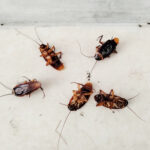How Can We Help?
How do cockroaches move?
Cockroaches are incredibly agile and efficient movers, using their six legs to get around all sorts of environments. Each leg has three joints, giving them the flexibility for quick movement. Their legs are also covered with tiny sensory hairs that help them detect changes in their surroundings and stay balanced. Cockroaches move using a tripod gait, where three legs are always on the ground while the other three move forward, allowing them to run fast and smoothly. This way of moving gives them stability and speed, with some even capable of reaching up to 3 miles per hour. Plus, they have a pair of cerci, sensory appendages at the back, which detect vibrations and help them react quickly to threats. All these physical traits make cockroaches very effective and versatile movers.
hairs that help them detect changes in their surroundings and stay balanced. Cockroaches move using a tripod gait, where three legs are always on the ground while the other three move forward, allowing them to run fast and smoothly. This way of moving gives them stability and speed, with some even capable of reaching up to 3 miles per hour. Plus, they have a pair of cerci, sensory appendages at the back, which detect vibrations and help them react quickly to threats. All these physical traits make cockroaches very effective and versatile movers.
How do cockroaches use their wings to move?
Cockroaches mainly use their wings for gliding and short bursts of flight rather than flying long distances. Most species have two pairs of wings: the tougher forewings (tegmina) and the flexible hindwings. When they feel threatened or need to move quickly over short distances, cockroaches might unfold their hindwings by extending the tegmina. These larger hindwings help them lift off and glide to safety. However, many cockroach species, especially common household ones like the German cockroach, aren't strong fliers. They usually use their wings to help with controlled falls or jumps from higher spots. The wings also help them navigate and keep their balance while moving. So, even though cockroaches are mostly ground-dwellers, their wings give them an extra way to move around, making it easier for them to escape predators and find food.
What adaptations allow cockroaches to squeeze through tiny cracks?
Cockroaches have a bunch of cool adaptations that let them squeeze through tiny cracks. Their bodies are super 
